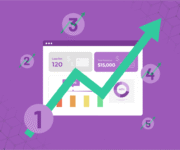Thanks to technological advancements, loan management software has evolved immensely over the past decade. By 2032, AI and automation market in the banking industry is estimated to be worth USD 182 billion.
In today’s digital age, lending institutions seek new and innovative ways to streamline their loan management processes. Artificial intelligence (AI), automation, and blockchain technology are emerging trends transforming the loan management software landscape.
This article discusses how artificial intelligence, automation, and blockchain are revolutionising the loan management landscape.
Loan Management System: An Overview
A loan management system helps financial institutions manage the entire loan process, from origination to repayment. Lenders can make better lending decisions using real-time loan data by streamlining the loan process and automating routine tasks.
It also helps lenders monitor loan performance, track payments, and manage collections. The system can manage various types of loans, including personal loans, auto loans, mortgages, and small business loans for banks, credit unions, and mortgage companies.
With a loan management system in place, lenders can improve their efficiency, reduce operational costs, and provide better customer service to borrowers.
Overall, it assists lenders and borrowers in lending and ensures that loans are managed efficiently.
Role of AI in Loan Management Software
Artificial intelligence (AI) can potentially transform the loan management industry significantly. It can automate routine tasks, improve decision-making, and enhance customer experience.
AI-powered loan management software can analyse vast amounts of data to identify patterns, trends, and anomalies that traditional systems cannot detect. It can also give lenders insights that enable them to make informed decisions.
Some AI Trends in Loan Management Software
There are several conceivable trends to watch for regarding artificial intelligence in loan management software:
1. Risk Assessment
AI can help lenders better assess risk by analysing data from multiple sources, including credit reports, financial statements, and social media profiles. This enables lenders to make more informed decisions about approving a loan and at what interest rate.
2. Fraud Detection
Using artificial intelligence (AI), lenders can detect fraud by analysing patterns in data that may reflect fraudulent activity to identify and prevent fraudulent loan applications from being submitted. This method allows them to detect and prevent fraudulent loan applications from being submitted.
3. Chatbots and Virtual Assistants
AI-powered chatbots and virtual assistants can provide borrowers personalised guidance and support throughout the loan application process. This can help borrowers navigate complex loan requirements and increase the chances of successful loan approval.
4. Predictive Analytics
AI can be used to analyse historical data and predict future loan performance. This can help lenders identify potential risks and proactively manage their loan portfolios. As technology evolves, we can expect new and innovative ways to use AI in loan management software, which could redefine loan management software.
Automation in Loan Management Software
Automation involves the use of technology to streamline and automate various processes associated with loan management, such as loan origination, underwriting, and servicing.
The use of automation in loan management software can significantly reduce the time and cost associated with lending.
Impact of Automation on Loan Management Software
Here are some of the ways automation is changing loan management software:
1. Faster loan processing
With automated loan management software, lenders can process loan applications much faster. The software can automatically pull in borrower data, verify employment and income information, and check credit scores.
This means that lenders can make quick decisions about loan approvals and get funds to borrowers more quickly.
2. Improved risk management
Automation can also help lenders manage risk more effectively. With automated underwriting and loan analysis, lenders can quickly identify high-risk loans and take steps to mitigate that risk. This can help prevent defaults and minimise losses.
3. Personalised borrower experiences
With automation, lenders can provide borrowers with a more personalised experience. For example, automated loan management software can send borrowers targeted messages based on their loan status and payment history. This can help improve customer satisfaction and retention.
4. Better compliance
Automation can also help lenders stay compliant with regulations and avoid costly fines. Loan management software can automatically generate reports and disclosures required by regulators, ensuring that lenders are always in compliance.
In the coming years, automated loan management software will allow lenders to process loans faster and manages risks more effectively.
Blockchain Integration in Loan Management Software
Blockchain integration is an emerging trend in loan management software that has the potential to revolutionise the way loans are managed and processed. Blockchain is a decentralised digital ledger that records transactions securely and transparently.
Using Blockchain in loan management processes
Here are some potential future trends in loan management software that are related to blockchain integration:
1. Decentralised lending
The integration of blockchain technology makes transactions between lenders and borrowers faster and easier. Ultimately, this could reduce transaction costs and increase access to credit for underserved populations by decentralising lending.
2. Smart contract
It is a self-executing contract where the terms are coded directly between the buyer and seller. With blockchain technology, these contracts can be recorded and executed automatically without intermediaries, reducing the time and cost of processing loan applications.
3. Improved data security
The blockchain can protect user data by ensuring that sensitive information is not compromised, as it provides a decentralised, tamper-proof system for storing sensitive loan information. Data breaches and other security risks will be reduced because of this.
Final thoughts
The financial ecosystem is evolving, and lenders must adopt new technologies to remain competitive. AI, automation, and blockchain integration are the future trends transforming the loan management landscape. Adopting these technologies can enhance efficiency, reduce risks, and improve customer experience.
Integrated with such technologies, loan management software can lead the digital revolution, and lenders that embrace these changes will emerge as winners in the competitive landscape.
Also, with the introduction of fintech tools to loan management, loan approvals and disbursements are further streamlined and automated.
A cutting-edge tool offered by the fintech platform Finezza is the Loan Management System (LMS), which combines bank and NBFC synergies to create an effective tool. In addition to managing the entire lending lifecycle, this module provides clients with unique document recognition and data extraction capabilities.
Aside from automating the entire lending process, it also offers analytics and other specialised solutions like API integrations, allowing traditional lenders to quickly process a high volume of loans.
Sign up to learn more about Finezza!




Leave a Reply